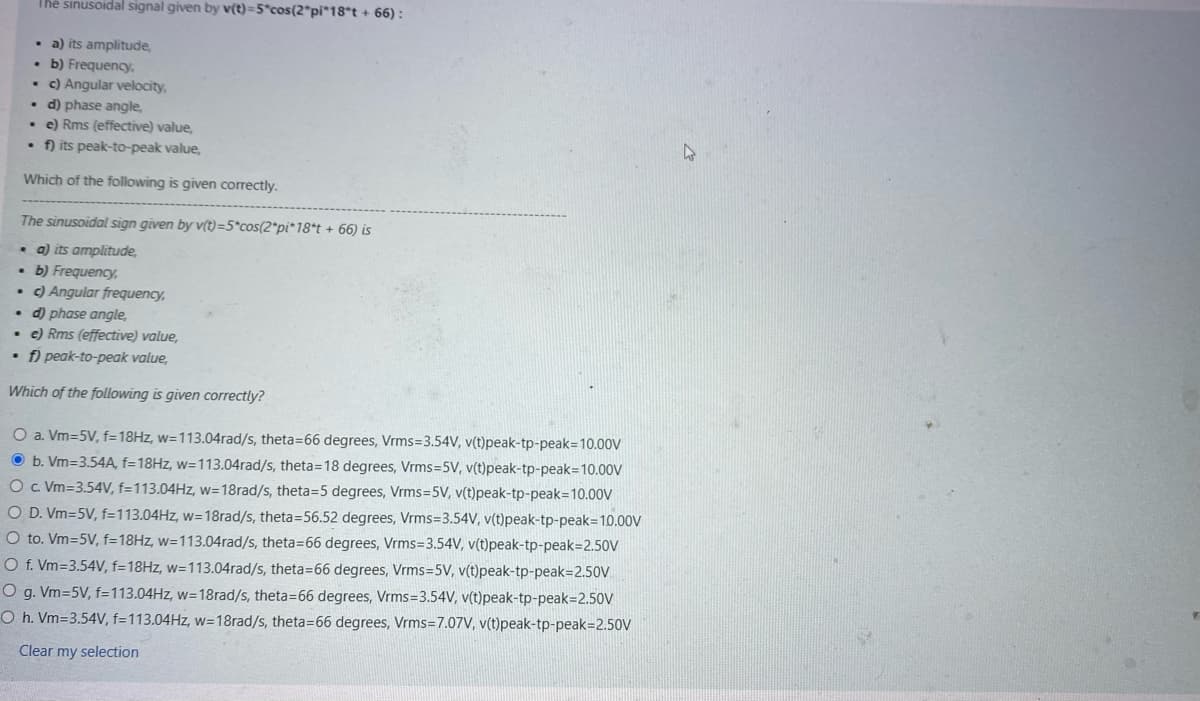The sinusoidal signal given by v(t)=5*cos(2 pi*18"t+ 66): . a) its amplitude, . b) Frequency. . c) Angular velocity, . d) phase angle, . e) Rms (effective) value, . f) its peak-to-peak value, Which of the following is given correctly. The sinusoidal sign given by v(t)=5*cos(2*pi*18*t +66) is . a) its amplitude, • b) Frequency, . c) Angular frequency, . d) phase angle, . e) Rms (effective) value, . f) peak-to-peak value, Which of the following is given correctly? O a. Vm=5V, f=18Hz, w=113.04rad/s, theta=66 degrees, Vrms=3.54V, v(t)peak-tp-peak-10.00V b. Vm=3.54A, f=18Hz, w=113.04rad/s, theta=18 degrees, Vrms=5V, v(t)peak-tp-peak-10.00V O c. Vm=3.54V, f=113.04Hz, w=18rad/s, theta=-5 degrees, Vrms=5V, v(t)peak-tp-peak-10.00V O D. Vm=5V, f=113.04Hz, w=18rad/s, theta=56.52 degrees, Vrms=3.54V, v(t)peak-tp-peak=10.00V O to. Vm=5V, f=18Hz, w=113.04rad/s, theta=66 degrees, Vrms=3.54V, v(t)peak-tp-peak-2.50V O f. Vm=3.54V, f=18Hz, w=113.04rad/s, theta=66 degrees, Vrms=5V, v(t)peak-tp-peak-2.50V O g. Vm=5V, f-113.04Hz, w=18rad/s, theta=66 degrees, Vrms=3.54V, v(t)peak-tp-peak=2.50V O h. Vm=3.54V, f=113.04Hz, w=18rad/s, theta=66 degrees, Vrms=7.07V, v(t)peak-tp-peak=2.50V Clear my selection
The sinusoidal signal given by v(t)=5*cos(2 pi*18"t+ 66): . a) its amplitude, . b) Frequency. . c) Angular velocity, . d) phase angle, . e) Rms (effective) value, . f) its peak-to-peak value, Which of the following is given correctly. The sinusoidal sign given by v(t)=5*cos(2*pi*18*t +66) is . a) its amplitude, • b) Frequency, . c) Angular frequency, . d) phase angle, . e) Rms (effective) value, . f) peak-to-peak value, Which of the following is given correctly? O a. Vm=5V, f=18Hz, w=113.04rad/s, theta=66 degrees, Vrms=3.54V, v(t)peak-tp-peak-10.00V b. Vm=3.54A, f=18Hz, w=113.04rad/s, theta=18 degrees, Vrms=5V, v(t)peak-tp-peak-10.00V O c. Vm=3.54V, f=113.04Hz, w=18rad/s, theta=-5 degrees, Vrms=5V, v(t)peak-tp-peak-10.00V O D. Vm=5V, f=113.04Hz, w=18rad/s, theta=56.52 degrees, Vrms=3.54V, v(t)peak-tp-peak=10.00V O to. Vm=5V, f=18Hz, w=113.04rad/s, theta=66 degrees, Vrms=3.54V, v(t)peak-tp-peak-2.50V O f. Vm=3.54V, f=18Hz, w=113.04rad/s, theta=66 degrees, Vrms=5V, v(t)peak-tp-peak-2.50V O g. Vm=5V, f-113.04Hz, w=18rad/s, theta=66 degrees, Vrms=3.54V, v(t)peak-tp-peak=2.50V O h. Vm=3.54V, f=113.04Hz, w=18rad/s, theta=66 degrees, Vrms=7.07V, v(t)peak-tp-peak=2.50V Clear my selection
Introductory Circuit Analysis (13th Edition)
13th Edition
ISBN:9780133923605
Author:Robert L. Boylestad
Publisher:Robert L. Boylestad
Chapter1: Introduction
Section: Chapter Questions
Problem 1P: Visit your local library (at school or home) and describe the extent to which it provides literature...
Related questions
Question
Electrical circuit

Transcribed Image Text:The
sinusoidal signal given by v(t)=5*cos(2 pi*18*t +66):
. a) its amplitude,
. b) Frequency.
. c) Angular velocity,
d) phase angle,
. e) Rms (effective) value,
. f) its peak-to-peak value,
Which of the following is given correctly.
The sinusoidal sign given by v(t)=5*cos(2*pi*18*t +66) is
. a) its amplitude,
• b) Frequency,
. c) Angular frequency,
. d) phase angle,
. e) Rms (effective) value,
. f) peak-to-peak value,
Which of the following is given correctly?
O a. Vm=5V, f=18Hz, w=113.04rad/s, theta=66 degrees, Vrms=3.54V, v(t)peak-tp-peak-10.00V
b. Vm=3.54A, f=18Hz, w=113.04rad/s, theta=18 degrees, Vrms=5V, v(t)peak-tp-peak-10.00V
O c. Vm=3.54V, f=113.04Hz, w=18rad/s, theta=5 degrees, Vrms=5V, v(t)peak-tp-peak-10.00V
O D. Vm=5V, f=113.04Hz, w=18rad/s, theta=56.52 degrees, Vrms=3.54V, v(t)peak-tp-peak=10.00V
O to. Vm=5V, f=-18Hz, w=113.04rad/s, theta=66 degrees, Vrms=3.54V, v(t)peak-tp-peak-2.50V
O f. Vm=3.54V, f=18Hz, w=113.04rad/s, theta=66 degrees, Vrms=5V, v(t)peak-tp-peak-2.50V
O g. Vm=5V, f-113.04Hz, w=18rad/s, theta=66 degrees, Vrms=3.54V, v(t)peak-tp-peak-2.50V
O h. Vm=3.54V, f=113.04Hz, w=18rad/s, theta=66 degrees, Vrms=7.07V, v(t)peak-tp-peak=2.50V
Clear my selection
Expert Solution
This question has been solved!
Explore an expertly crafted, step-by-step solution for a thorough understanding of key concepts.
Step by step
Solved in 3 steps with 3 images

Knowledge Booster
Learn more about
Need a deep-dive on the concept behind this application? Look no further. Learn more about this topic, electrical-engineering and related others by exploring similar questions and additional content below.Recommended textbooks for you

Introductory Circuit Analysis (13th Edition)
Electrical Engineering
ISBN:
9780133923605
Author:
Robert L. Boylestad
Publisher:
PEARSON

Delmar's Standard Textbook Of Electricity
Electrical Engineering
ISBN:
9781337900348
Author:
Stephen L. Herman
Publisher:
Cengage Learning

Programmable Logic Controllers
Electrical Engineering
ISBN:
9780073373843
Author:
Frank D. Petruzella
Publisher:
McGraw-Hill Education

Introductory Circuit Analysis (13th Edition)
Electrical Engineering
ISBN:
9780133923605
Author:
Robert L. Boylestad
Publisher:
PEARSON

Delmar's Standard Textbook Of Electricity
Electrical Engineering
ISBN:
9781337900348
Author:
Stephen L. Herman
Publisher:
Cengage Learning

Programmable Logic Controllers
Electrical Engineering
ISBN:
9780073373843
Author:
Frank D. Petruzella
Publisher:
McGraw-Hill Education

Fundamentals of Electric Circuits
Electrical Engineering
ISBN:
9780078028229
Author:
Charles K Alexander, Matthew Sadiku
Publisher:
McGraw-Hill Education

Electric Circuits. (11th Edition)
Electrical Engineering
ISBN:
9780134746968
Author:
James W. Nilsson, Susan Riedel
Publisher:
PEARSON

Engineering Electromagnetics
Electrical Engineering
ISBN:
9780078028151
Author:
Hayt, William H. (william Hart), Jr, BUCK, John A.
Publisher:
Mcgraw-hill Education,